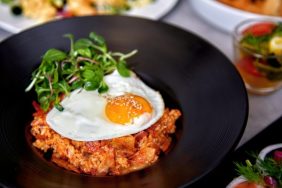If your experience of eating potatoes is limited to hash browns, fries, and tots, a new cookbook is going to expand your tuber horizons. Smashed, Mashed, Boiled, and Baked–and Fried, Too! (Workman) is a cacophony of all things potato-related. Infused with flavors from all over the world, these 75 creative recipes by James Beard Award-winner Raghavan Iyer will have you dishing up potatoes in forms you never fathomed. Potato Empanadas! Potato Knishes! Potato Pierogies! Lefse! Potatoes morning, noon, and night!
We asked Iyer for tips on matching the right potato to its ideal recipe and for a few of his favorite ways to enjoy spuds.
Crave: What do you love about potatoes? Why did you want to dedicate a cookbook to them?
Raghavan Iyer: It’s a love affair that began about 55 years ago. I’ve always been passionate about potatoes, ever since I was growing up. Every book that I have written prior to the potato book, they were all basically books on Indian and Asian cooking. Even in those books, the first recipes I’d try to create were the potato recipes. I work with a lot of flavors and spices and I thought, “How could I take that and spread it to the world?” To me, the potato was the perfect medium for that.

The Ultimate Mashed Potatoes
When buying potatoes, sometimes it’s hard to tell whether they’re good or not. What do you look for?
Obviously, you don’t want any potatoes that have started to sprout or the skin looks a little wrinkly. You want potatoes that are very firm. Always buy potatoes that are not stored in the refrigerator. When you refrigerate potatoes, the starch converts to sugars and you don’t want that. If you’re privy to buying potatoes from a farmer who has just dug them out of the ground at the tail-end of the growing season, that’s the best way. Store them in-tact in a cool, dark spot. That way, your potatoes will last for a very long time, pretty much all the way through wintertime in the right conditions.
Also: 6 Foods to Experiment With in a Slow Cooker
There are so many kinds of potatoes. What kinds work best with which recipes?
I broke the potato varieties into two main categories: floury potatoes, which are potatoes that are high in starch and low in moisture, like the Russet or the Yukon Gold. They lend themselves really well for baking, roasting, deep-frying, or even mashing. The other group of potatoes, waxy potatoes, are high moisture and low starch. Those are ideal for boiling and even pan-frying. When you want to maintain the integrity of the shape, those work really well because they are more cohesive. Some of the potatoes that people associate with potato salad, for example, are waxy potatoes. Fingerlings usually fall under this category as well.

Persian-Style Potatoes and Eggs
For those who aren’t so skilled in the kitchen, which potatoes are the easiest to work with?
I feel like the Yukon Gold was bred as an all-purpose potato. In terms of starch and moisture, they’re middle-of-the-road so they lend themselves to quite a few different techniques, including baking but also boiling. That’s always something to grab. The workhorse potato, which I feel most people use for basic preparations, is your Russet potato, your common, garden variety potato that you find everywhere. Those cover a fair amount of cooking techniques. You’re much more prudent going with the Russet or the Yukon Gold because of their versatility.
Are there any kitchen tools that are particularly important to have on hand when you’re cooking with potatoes?
A good peeler is always important. A box grater usually works well if you’re looking for something all-purpose because on one side you can shred the potatoes and on the other side you can slice them. If you have these two, you can cover a fair amount of recipes.
For french fries, what kind of potato do you use and how do you achieve the right amount of crispiness?
In the book, I have a recipe called The Ultimate French Fries (at top). For that one, the potato that works the best is the Russet potato. You cut them up into the french fry shape using a mandolin or a knife and once you cut them up into the right width, length, and thickness, it’s a double-frying method that generates the best french fry. The first frying is usually at a lower-temperature oil, about 325 degrees, and once the potatoes are not quite brown and are cooked just a little bit, fairly white, that’s when you take them out of the oil. I actually toss them with just a little bit of cornstarch and then I freeze the potatoes. That way you can keep them frozen until you’re ready to fry them.
It’s the second frying that generates the right color and the right texture. For the second frying, the oil temperature is at 375 or even 400 degrees. You can take them directly out of the freezer and add them to that hot oil. You re-fry them and that’s when you get the crispiness and the color. In some ways, it makes it easier when you cook it that way. You always have your own frozen french fries on hand.
You have several sweet recipes in the book. It probably doesn’t occur to many people that they can incorporate potatoes into dessert.
Yeah. The book also has a handful of sweet potato recipes even though it is not the same plant. It’s a different species. Some of the dessert recipes lend themselves well to sweet potatoes, but there’s one potato dessert recipe I use with Russets. They’re potato crisps that are double-fried like the french fries and after they come out the second time, I dip them in dark chocolate and I sprinkle the dark chocolate with lavender sea salt. It’s a great dessert. If you just serve a handful of those with a bowl of really good premium ice cream, you have an amazing combination.
You have recipes from many countries in the book. How did you go about researching the different ways potatoes are prepared?

Potato Leek Pie
Because they are the fourth largest crop in the world, I wanted to take a worldly approach to working with tubers. When I create recipes, I don’t like to look at other cookbooks, particularly in that genre, because I feel that I second-guess my own creativity. So I looked at what are some of the classic dishes from particular countries that would lend themselves really well to switching it out with potatoes.
From Italy, I looked at the more comforting lasagnas. Using slices of potatoes between the pasta layers generates a really wonderful dish that is comforting and also recognizable. You look at France and you think about the classic potato leek soup, and I thought, what can I do that’s something different with that combination? So I turned it into a Potato Leek Pie. The crust is homemade—or people can buy a pre-done crust, which is fine—and then you bake it and serve it with a Roasted Jalapeño Sauce.
Those are some of the unusual takes. When you look at flavors from different parts of the world, their spicing combinations could be unique or the kind of herbs that they use are more particular, so that was the focus of using a worldly approach with the potato.
Do you find yourself going back to one of the recipes again and again?
Yes, especially on the weekends when I’m home, I always make myself Persian-style shredded potatoes. They’re sort of like hash browns. The shredded potatoes are tossed with a little bit of turmeric and chilies and red onions. You make them as you would do hash browns, on both sides. When you flip it over and cook the underside, that’s when you can actually crack open whole eggs, cover the pan and steam it. You get these beautifully steamed eggs, almost a poached egg concept, on top of those potatoes. It’s a complete dish, a one-pan dish, a beautiful looking dish. I usually do that as a steadfast favorite.








